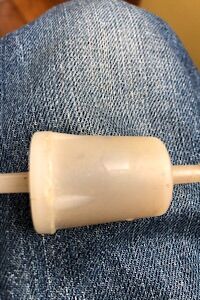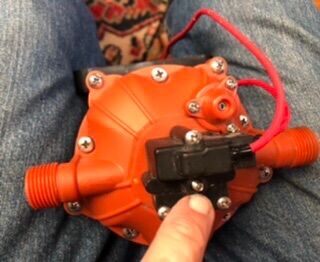

starman
-
Posts
1,950 -
Joined
-
Last visited
Content Type
Profiles
Forums
Events
Gallery
Blogs
Store
Posts posted by starman
-
-
Ive just got rid of a troublesome Seaflo water pump and fitted a new Sureflo as it has like for like connectors.
Worked fine for a few days. Then we left the boat for a week, came back today, turned water back on, opened taps and the pump runs but won’t turn off!The water runs fine from all taps and I can’t find any trace of leaking anywhere. It’s been cold here but not cold enough to blow pipes.
Baffles me.It’s a surecal calorifier with accumulator, expansion vessel, prv and non return valve.
Any suggestions very gratefully received. This water system is jinxed! -
-
I stopped, had a cup of tea and thought ‘ heat shrink’ - and if our Tony suggests it too then it must be ok.
There have been too many niggling problems with this job so that one really irritated. Grrh.42 minutes ago, Tony Brooks said:Get some adhesive heat shrink so you can cut back more of the outer sheath and the sleeve it with the heat shrink. If that leaves the cable too thin just add another layer of heat shrink.
1 minute ago, ditchcrawler said:So why have they only made the connection suitable for 1.5mm.?
Exactly!
-
I’ve got a bag of crimped ferrules; if I crimp them on the end of the inners I can’t manipulate them into the terminals with the tiny length of inner I can use before reaching the outer’s clamp.
I don’t see why crimps would make it easier anyway - it’s the thickness of the cable in relation to the plug that’s the issue - I can’t pull the two Halves together
-
-
17 minutes ago, David Mack said:
Better surely to connect the house side of the shunt to the engine battery negative, and then share the return wire from there to the starter motor as the hull connection.
Next question - how is that ‘close to’ any possible AC bonding point? Must be 12ins minimum on mine.
-
15 minutes ago, Jen-in-Wellies said:
Assuming you have a separate engine starter battery from your house batteries, the engine battery negative terminal will be at hull and engine battery voltage. The house battery negative at a slightly different (mV levels) voltage, depending on what current is flowing through the shunt. You would use the same size wire from the engine battery to the engine as you've used for the starter motor positive. Personally, I'd use the same size wire to connect engine to hull. Also take a similar sized wire from the house negative on the house side of the shunt to the hull. The wire lengths will be short and then there is no question about their current carrying capacity. Currents flowing through them should be minimal, excepting the starter return wire from the engine.
The engine battery negative and house battery negative are not connected directly together, otherwise the shunt won't be measuring house batt current in and out.
Now my old grey matter is seriously struggling.
I already have a 50mm2 +ve to the starter solenoid, a 50mm2 -ve to the starter and a 50mm2 -ve from the start battery to the house side of the shunt.
All correct so far?You’re saying add a further 50mm2 cable from the house side to my hull bonding point (which will need to be close to my AC hull bond).
I know one thing for sure - I wish I’d bought a Smartbank system like I had in the last boat. None of this complicated shunt stuff, just a relay a couple of wires and a box of tricks.
-
I’m plodding through my new electrical installation and have arrived at earth bonding: plenty has been written here about the AC side and I think I follow all that it’s the DC side that’s puzzling me.
Im fitting a Victron shunt and following the instruction that all negatives return to the shunt and then a single connection to the battery. That includes the hull earth grounding lead (and also in Victron’s guide, the Multiplus case earth)The question: what size cable for my 12v ground? Or how do I work it out?
Im also a bit bit bemused because it’s a trad engine solidly mounted to steel and therefore already earthed via the starter negative.
-
22 minutes ago, Detling said:
Do check that the plastic filter is bss compliant, usually plastic is a no no.
I think that's only in the engine space (mine's under the back cabin floor. But I've got four years before I find out 😏
-
IT'S RUNNING!!
Swapped out the modern alloy filter for the little plastic job - a couple of tries later and it burst into life.
A little bit of smoke from the joint into the silencer which I'll sort after it's had a run but otherwise ok 🤞.
Thanks for all the advice.
-
-
It’s fuel - I’ve cracked the pipe and it’s not getting through. The pump speeds up and the first bubble or two starts to appear then the system cuts out.
Is there a way to run the pump without the heater etc to draw fuel through? -
7 minutes ago, MtB said:
And the temperature of the exhaust, for the third time of asking?!
Fuel pump ticking, heater and circ pump running but exhaust cold (though no sign of smoke this time either).
-
Just now, MtB said:
And the temperature of the exhaust, for the third time of asking?!
If I can persuade it to fire again I'll stick my hand there...apologies for not answering question properly teacher; I thought exhaust smoke was sufficient evidence..
-
Just now, MtB said:
So is it lighting then going out? Or not lighting at all in th first place?
Find out by feeling the exhaust gas temperature.
It's lighting (smoky exhaust evidence) then shuts after 10-20 secs.
-
The flue pipe from stove to roof gets very, very hot. For personal protection buy one of the Refleks guards that encircles it. They look good too.
-
46 minutes ago, starman said:
Tried it this morning (checking jetty wasn’t covering exhaust) and it went through the sequence and clearly fired - slightly blue exhaust. Then it stopped!’Now all I’m getting is the hum of the pump. No circulation problem - two pipe header as Webasto recommend - and watching water bubbling through it. All rads bled.
Now I've discovered another re-set sequence – take out fuse 3secs - put in 'start' - take out 3 secs - in again. That got everything working but still stops after a period. Now to check fuel (with the inevitable leaks afterwards as per usual diesel work).
PS I am missing Fuse 3 in the unit fuse box - never was there and the system worked okay. What's it for?
-
12 hours ago, MtB said:
Yeahbutnobutyerahbutnobut, that's not what the OP describes.
His winds up like the jet engine you describe (all normal so far with combustion established), then it stops dead. The stopping dead is typical of an overheat thermostat stepping in and shutting it down. No water circulation is the probable cause of the overheat.
Tried it this morning (checking jetty wasn’t covering exhaust) and it went through the sequence and clearly fired - slightly blue exhaust. Then it stopped!’Now all I’m getting is the hum of the pump. No circulation problem - two pipe header as Webasto recommend - and watching water bubbling through it. All rads bled.
-
I press the 'fire' button, the fan starts whirring, the pump starts ticking then the whirring gets louder and faster and the ticking gets faster and faster until even the dog prepares to abandon ship! And I don my tin hat. Then it stops.
It's a Thermotop C; I've moved to a new location in the boat. It worked before though it has been stood around a while before attempted re-firing.
The manual is suitably vague about it cycling through the start process: do I have to keep manually starting it and how do I know it it's locked out? TBH it doesn't ever make the sort of firing up sound I hear in a central heating boiler.
-
I've decided to install a Victron Easyplus Combi because, as the name says, it's easy to fit and that suits me. Inverter, charger and breaker panel all in one unit. Connect a few cables and off I go.
So the question is: as there is an RCD in the Easyplus do I need to fit another immediately after the shoreline connection? As far as I can see it'll only be protecting about a metre of cable which is already protected by the shoreline breaker.
12v question: on my last boat I fitted a Smartgauge/Smartbank combo - I know it has its limitations in battery monitoring but it worked for us as we cruise a lot and tend to keep the batteries well topped up. Should I stick with it or go for a Victron BMV monitor and different VSR?
-
Our steel-under-canvas boat lacks the canvas bit at the moment. It’s obviously a bit more specialised than the regular cratch cover - does anyone have any recommendations for someone who does this sort of work?
-
On 02/10/2021 at 09:50, starman said:
Recently fitted a Seaflo domestic water pump, the system seems to operate well with no leaks but after taps have been run for a longish time the pump runs on and on and on before switching off. There’s an accumulator in the system set at 19psi
The spec says the pump has a shut off pressure of 60psi - could the need to build pressure up to what seems pretty high be the cause?I have done a semi-permanent fix by discovering a somewhat elderly Sureflo 3901-0213 pump buried in my ‘may be useful’ box.
It’s certainly cured the lengthy pump running but now the system is rather slow running instead!
Now the Seaflo is out I’ve also seen it seems to have a pressure adjuster. I’ll have to have a play. -
Just now, dmr said:
I think Seaflo are a direct copy of Shurflo rather than Jabsco, the mouldings look identical (maybe even from the same production line????) though sometimes in a different colour. This is what can happen when a company moves their production to China. Its the the same with Stanadyne injectors, you can buy an expensive Stanadyne made in China or a cheaper Chinese made in China injector.
Sorry - brain failure; the name should have been a clue!
-
13 minutes ago, MtB said:
I agree. I'm wondering what led the OP to fit the Seaflo pump with 60psi cut off. What make and model was the old pump (which presumably worked satisfactorily for many years)? Changing one component to one of a different specification in any system usually leads to trouble!
There was no old one, it’s a completely new system. Seaflo, as far as I know, is a Chinese knock-off of Jabsco. They do a lot of water and bilge pumps. Why did I pick this one? As many of us do, I just saw something on EBay that looked right and went ‘click’ - I dare say I can fit a Square D pressure switch to sort it (if I can pick the right one of those 🤣).





Water pump won’t shut off
in Boat Building & Maintenance
Posted
Only 10v which I’m very surprised at.